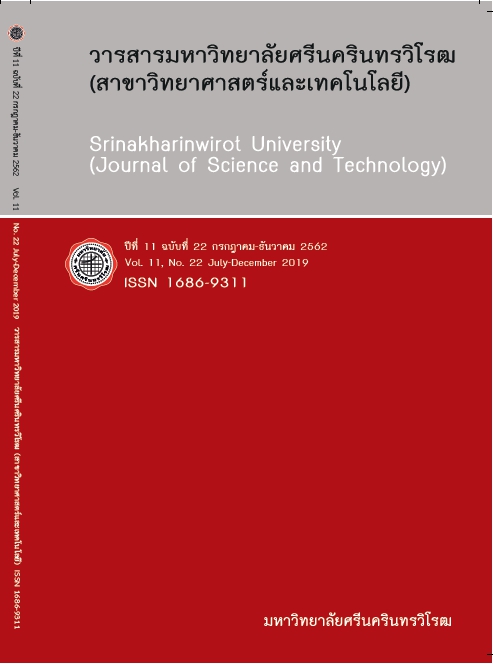ผลของอุณหภูมิการแช่เย็นขั้นปฐมภูมิต่อการสูญเสียน้ำหนักของซากสุกรและคุณภาพ ของเนื้อสันนอก (EFFECT OF PRIMARY CHILLING TEMPERATURE ON WEIGHT LOSS OF PORCINE CARCASS AND QUALITY OF SIRLOIN MEAT)
Keywords:
Primary Chilling Temperature, Porcine Carcass, pH, Shear Force, Weight LossAbstract
This research aimed at investigating effect of primary chilling temperatures under high humidity on weight loss and sirloin meat quality. Three primary chilling temperatures (-5°C, -10°C and -20°C) were applied to porcine carcasses until their temperatures reached 35°C. Subsequently, the carcasses were conventionally chilled (secondary chilling) at 0°C for 22 h. The results showed that primary chilling temperature did not show significant effect on pH of carcasses (P>0.05). The pH of carcasses decreased to 6.40-6.87 and 5.90-6.20 after 45 min and 24 h post mortem, respectively. The lowest weight loss of 1.57±0.17% was found in sample undergone primary chilled at -20°C. This might be due to the ice glazing as a protecting agent during carcass chilling. After overnight chilling, carcasses were cut and sirloin meat was chilled before determining its qualities. Primary chilling temperature significantly affected shear force (P<0.05) but not drip loss of the raw meat (P>0.05). Raw meat experienced primary chilled at -20°C had the significantly lowest shear force of 2.17+0.96 kg/cm2. However, there was no significant difference in cooking loss and texture quality of meat after cooking (P>0.05). The study indicates that lowering primary chilling temperature could improve weight loss of sirloin meat without significant effect on its texture quality.
Downloads
References
[2] Saleem M.U., and Majeed, K.A. (2014, March). Chilling systems and effect of temperature on tenderness and appearance of meat post slaughter: A Review. IJAR. 2(3), 129-135.
[3] Wal van der, P. G., Engel, B., Van Beek, T. G., and Veerkamp, C.H. (1995). Chilling pig carcasses: Effects on temperature, weight loss and ultimate meat quality. Meat Sci. 40(2), 193-202.
[4] Drumm, B. M., and McKenna, B. M. (1992). Line chilling of beef 2: The effect on carcass temperature, weight loss and toughness. J. Food Eng. 15(4), 285-312.
[5] Tomović, V.M., Petrović, L.S., and Džinić, N.R. (2008, December). Effects of rapid chilling of carcasses and time of deboning on weight loss and technological quality of pork semimembranosus muscle. Meat Sci. 80(4), 1188-1193.
[6] O’Neill, D. J., Lynch, P. B., Troy, D. J., Buckley, D. J., and Kerry, J. P. (2003, June). Influence of the time of year on the incidence of PSE and DFD in Irish pig meat. Meat Sci. 64(2), 105-111.
[7] Mota-Rojas, D., Becerril, M., Lemus, C., Sánchez, P., González, M., and Olmos, S. A. (2006, July). Effects of mid-summer transport duration on pre- and post-slaughter performance and pork quality in Mexico. Meat Sci. 73(3), 404-412.
[8] S. Barbut, S., Sosnicki, A.A., Lonergan, S.M., Knapp, T., Ciobanu, D.C., Gatcliffe, L.J., Huff-Lonergan, E., and Wilson, E.W. (2008, May). Progress in reducing the pale, soft and exudative (PSE) problem in pork and poultry meat. Meat Sci. 79(1), 46-63.
[9] Rybarczyk, A., Karamucki, T., Pietruszka, A., Rybak, K., and Matysiak, B. (2015, March). The effects of blast chilling on pork quality. Meat Sci. 101, 78-82.
[10] Krzywicki, K. (1979, January). Assessment of relative content of myoglobin, oxymyoglobin and metmyoglobin at the surface of beef. Meat Sci. 3(1), 1-10.
[11] Juárez, M., Caine, W. R., Larsen, I. L., Robertson, W. M., Dugan, M. E. R., and Aalhus, J. L. (2009, November). Enhancing loin quality attributes through genotype, chilling method and ageing time. Meat Sci. 83(3), 447-453.
[12] Li, K., Zhang, Y., Mao, Y., Cornforth, D., Dong, P., Wang, R., Zhu, H., and Luo, X. (2012, March). Effect of very fast chilling and aging time on ultra-structure and meat quality characteristics of Chinese Yellow cattle M. Longissimus lumborum. Meat Sci. 92(3), 795-804.
[13] Honikel, K. O. (1999). Biochemical and physico-chemical characteristics of meat quality. Meat Tech. 40, 105-123.
Downloads
Published
How to Cite
Issue
Section
License
Srinakharinwirot University Journal of Sciences and Technology is licensed Under a Creative Commons Attribution-NonCommercial-NoDerivs 4.0 International (CC-BY-NC-ND 4.0) License, Unless Otherwise Stated. Please Read Journal Policies Page for More Information on Open Access, Copyright and Permissions.



